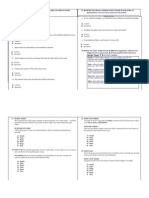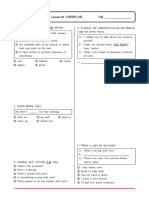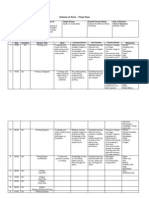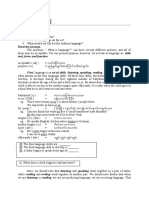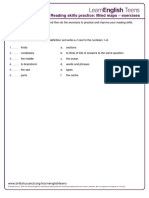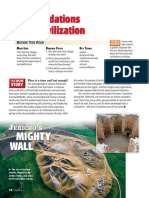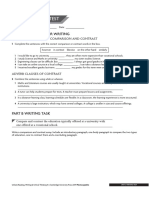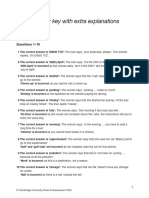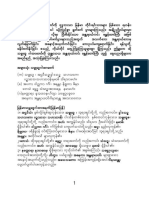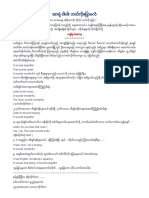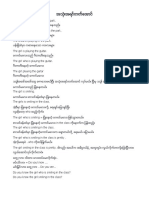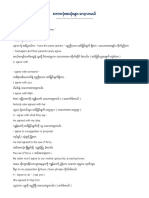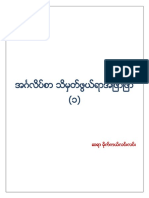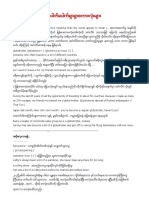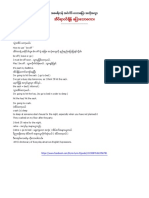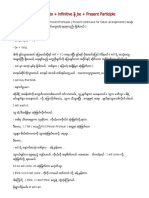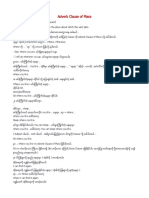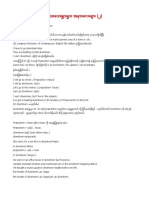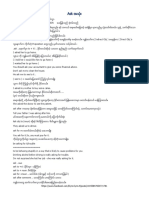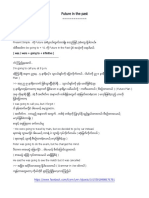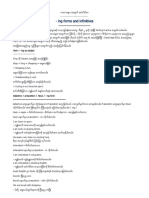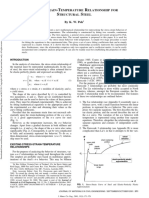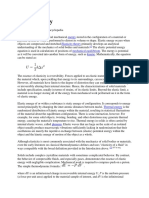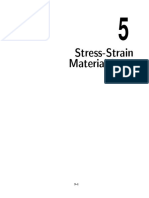ေလ့လာမိသမွ် ဆယ္တန္းရူပ(တကၠသိုလ၀
္ င္တန္းအဆင့္) U R Kar Phyo ( BEd )
CHAPTER 1; WORK DONE AND POWER
Work done ( )
၄ (work)
၍ ၍
၏
W =
W = F s cos or) W = F cos
‘ ’ ( )
Power ( )
power ( )
concept
Power concept
Power ၏
Machine ( )
၏
( " " 20N
၍ ’ ’ 20N )
(၃) (1) The lever (eg a crowbar) (2) The inclined plane ( eg. a screwjack) (3)
The hydraulic press ( eg brake system of a car )
Mechanical advantage ( ၏ )
effort (P)
၄ (Load'W')
load(W) effort(P) ၏ mechanical advantage(MA)( ၏
mechanical advantage(MA)
velocity ratio ( )
၏ Velocity Ratio(VR)
1
� ေလ့လာမိသမွ် ဆယ္တန္းရူပ(တကၠသိုလ၀
္ င္တန္းအဆင့္) U R Kar Phyo ( BEd )
VR MA VR MA ၍
VR one
Input work and output work
” effort
(
load (
Efficiency
Output work input work ၏
efficiency
Perfect machine
efficiency 100% (perfect machine)
perfect machine output work input work
၁ % input work
output work
Elasticity
elasticity ( ) ( )
Elastic limit ( / )
၄ ၏
elastic limit
၍
’ la
2
� ေလ့လာမိသမွ် ဆယ္တန္းရူပ(တကၠသိုလ၀
္ င္တန္းအဆင့္) U R Kar Phyo ( BEd )
Work done ( )
၁ ၄ (work)
၍
၍
၂ ၏
W =
W = F s cos or) W = F cos
၃ ‘ ’ ( )
၄ ၏ joule, erg, foot-pound
၁ ၄ (work)
၍
၍
(work)
၏
၍ ၍
" ”
( )
၂ ၏
(၁ )
၏
( )
၏ ၅
၁
3
�ေလ့လာမိသမွ် ဆယ္တန္းရူပ(တကၠသိုလ၀
္ င္တန္းအဆင့္) U R Kar Phyo ( BEd )
၏
၏ ၏
quantity Symbol
work W
Force applied F
displacement S
(work) W=F.s
၏ ၏
‘ ’
F
၏
s
(positive)
၏ W = F s (or) W= F.d
၏ ၍
၍ (negative)
၏ W =
၏
၏ X - Y component
X component
F
W = F s cos
W = F s cos or) W = F cos
( ) ၏
W = F s cos W = F s cos 90
” "h" " "
၏ " "
4
� ေလ့လာမိသမွ် ဆယ္တန္းရူပ(တကၠသိုလ၀
္ င္တန္းအဆင့္) U R Kar Phyo ( BEd )
၏ ၏ (weight)
၏ W= F.s
W= Fs
F=w h w(weight) h(height) )
w W= wh
weight, w=mg
W= mgh
၄ ၏ joule, erg, foot-pound
Force(F) Displacement Work done
SI newton metre Joule
C.G.S dyne centimetre erg
F.P.S pound foot foot-pound
equivalent unit of joule = newton - meter , equivalent unit of erg = dyne -centimetre
1N ၏ l
ala a
POWER
၁ power ( )
concept
၂ Power ၏ watt, erg per second, foot-pound per second
၃ Power concept
၄ Power ၏
၁ power ( )
concept
power ( )
(power)၏
power
5
� ေလ့လာမိသမွ် ဆယ္တန္းရူပ(တကၠသိုလ၀
္ င္တန္းအဆင့္) U R Kar Phyo ( BEd )
၃ ၏ (power)
Power
P= where, P= power, W= work done, t = time taken
၂ Power ၏ watt, erg per second, foot-pound per second
Power ၏ P=
Work done Time taken Power
SI Joule second watt
C.G.S erg second erg per second
F.P.S foot-pound second foot-pound per second
al a l
l power 1 watt
watt kilowatt (103W) megawatt (106W)
British engineering system power ၏
horse power 150pound
၏
1W =1Js-1, 1hp =746W = 746 x 107ergs-1 = 550 ft -lb s-1
၃ Power concept
(၂)
၍
power
( ) ၏ (power)
power
) ၍
၏
၏ (power)
power concept
6
� ေလ့လာမိသမွ် ဆယ္တန္းရူပ(တကၠသိုလ၀
္ င္တန္းအဆင့္) U R Kar Phyo ( BEd )
၄ Power ၏
၏
(power)
P=
P =power
W=F.s
F =force
v =velocity
P= =F. =Fv ( v= )
power (force) (velocity) ၏
Machine ( )
၁
၂
၏
၃ (၃) (1) The lever (eg a crowbar) (2) The inclined plane ( eg. a
screwjack) (3) The hydraulic press ( eg brake system of a car )
၁
၍
(machine)
(၁) ၍ ( )
(၂) ၍ ( ) ( )
(၃) ၍ ( )
၂
၏
'
၍
၏
" 20N
’ ’ 20N
7
� ေလ့လာမိသမွ် ဆယ္တန္းရူပ(တကၠသိုလ၀
္ င္တန္းအဆင့္) U R Kar Phyo ( BEd )
၃ (၃) (1) The lever (eg a crowbar) (2) The inclined plane ( eg. a
screwjack) (3) The hydraulic press ( eg brake system of a car )
( )
(၃) (၁) (၂ (၃
(lever)
၍
screwjack
၍ hydraulic
system
Hydraulic car brake
]
Mechanical advantage ( ၏ )
၁ effort (P)
၄ (Load'W')
8
� ေလ့လာမိသမွ် ဆယ္တန္းရူပ(တကၠသိုလ၀
္ င္တန္းအဆင့္) U R Kar Phyo ( BEd )
၂ load(W) effort(P) ၏ mechanical advantage(MA)( ၏
၃ mechanical advantage(MA)
၁ effort (P)
၄ (Load'W')
effort (P)
(Load'W')
pulley ၍
၏
l a
၂ load(W) effort(P) ၏ mechanical advantage(MA)( ၏
o d
Mechanical advantage (MA) =
effo
Mechanical advantage ၏ ” ၏ ” ၏
Load(W)၏ newton(N), dyne, l effort(P)၏
l MA unit
25N 100N ”
၏
o d
Mechanical advantage (MA) = = =4
effo
MA =4 ( ) ၄
၃ mechanical advantage(MA)
MA
MA=4 ၄
၄
၄
၏
velocity ratio ( )
၁
၏ Velocity Ratio(VR)
9
� ေလ့လာမိသမွ် ဆယ္တန္းရူပ(တကၠသိုလ၀
္ င္တန္းအဆင့္) U R Kar Phyo ( BEd )
၂ VR one
၁
၏ Velocity Ratio(VR)
1second 1second
၏ Velocity Ratio(VR)
( )
”
di nce moved by effo d
velocity ratio (VR) =
di nce moved by o d in he me ime
၂ VR one
”
‘ ’
‘ ” ”
၏ ၏
VR one
VR ၏
VR is always greater than one
VR
(load )၏
10
� ေလ့လာမိသမွ် ဆယ္တန္းရူပ(တကၠသိုလ၀
္ င္တန္းအဆင့္) U R Kar Phyo ( BEd )
Efficiency
၁
၂ output work ( )
၃ Output work input work ၏ efficiency
” input w effort
(
input work = effort (P) × distance moved by effort (d effort).
၂ output work ( )
”
( ) load (
Output work = load (W) x distance moved by load (dload)
effort
input work = effort (P) × deffort
deffort
effort
deffort output work = load(W) × dload. dload
load
dload
fulcrum load
deffort = ၏ dload = ၏
၃ Output work input work ၏ efficiency
𝑜𝑢𝑡𝑝𝑢𝑡 𝑤𝑜𝑟𝑘
Efficiency = x 100 %
𝑖𝑛𝑝𝑢𝑡 𝑤𝑜𝑟𝑘
efficiency၏ formula
output work load distance moved by load
efficiency 100 % 100%
input work effort distance moved by effort
load distance moved by load
100%
effort distance moved by effort
1
= MA 100%
VR
MA
efficiency 100%
VR
11
� ေလ့လာမိသမွ် ဆယ္တန္းရူပ(တကၠသိုလ၀
္ င္တန္းအဆင့္) U R Kar Phyo ( BEd )
Perfect machine
၁ efficiency 100% (perfect machine)
၂ ၁ %
၁ efficiency 100% (perfect machine)
efficiency 100% perfect machine
efficiency ၏ Efficiency = x 100 % 100%
output work input work output
work input work efficiency (100%) efficiency 100%
perfect machine perfect machine output work input work
perfect machine
efficiency 100% ( ) output work input work perfect machine
MA
effenciency ၏ efficiency 100%
VR
100% mechanical advantage velocity ratio
perfect machine
(၁) efficiency =100% (၂ (၃) MA = VR
(၃) perfect machine
၂ ၁ %
၏ output work
inpur work
output work efficiency 100%
100% efficiency
Elasticity and Elastic limit ( )
၁ elasticity ( ) ( )
၂
( )
၃ ၍
’ la
၁ elasticity ( ) ( )
12
� ေလ့လာမိသမွ် ဆယ္တန္းရူပ(တကၠသိုလ၀
္ င္တန္းအဆင့္) U R Kar Phyo ( BEd )
elasticity ( )
.
၂
( )
( )
sprin
၏ ( )
g
Limit limit
Limit elastic limit ( ) (a)
၏ elastic limit loa
(b) d
elastic body elastic limit
elastic body elastic
limit elastic limit
၃ ၍
’ la
elastic limit
၏ elastic limit ၍
elastic limit ၍
Robert Hooke
Hooke's law Hooke ”
a ”
’ La
quantity symbol formula
Applied force or stress F F x
Elongation or strain x F = kx (k=constant)
13
� ေလ့လာမိသမွ် ဆယ္တန္းရူပ(တကၠသိုလ၀
္ င္တန္းအဆင့္) U R Kar Phyo ( BEd )
Stress-strain graph
Hooke's law ၏ elastic limit
၍ stress( ) strain( )
၂
၂ ၂ ၄
၄
quantity a grap line straight line
Hooke's Law stress strain a
straight line
x (strain)
0 F (stress)
Fig: strain vs stress graph
stress strain ( )
stress strain
( ) graph line Straight line
stress X- strain Y-
elastic body
stress( ) strain( ) stress
stress X- Strain Y
14
� ေလ့လာမိသမွ် ဆယ္တန္းရူပ(တကၠသိုလ၀
္ င္တန္းအဆင့္) U R Kar Phyo ( BEd )
(၁)
ok
ok work done
(
( work done
)
)
( )
( )
work done
?( )
??
ok
??
( )
direction
?
?
( )
( )
(
)
ok
?
work done
)
work done W
F
Work
done
distance (d )
( s )
15
� ေလ့လာမိသမွ် ဆယ္တန္းရူပ(တကၠသိုလ၀
္ င္တန္းအဆင့္) U R Kar Phyo ( BEd )
= x ( cos
W=Fxs Sin )
work done formula
W = F.s ok F
Fcos@
Work done
Work may be defined as the product of force
applied and displacement.
ok ၍
?
(90° )
W = Fs cos@ 90°
??
(
) W= Fs cos90° cos90
( ( work done )
)
component " "
X., Y component
၂
( )
" " h
(
cosine )
16
� ေလ့လာမိသမွ် ဆယ္တန္းရူပ(တကၠသိုလ၀
္ င္တန္းအဆင့္) U R Kar Phyo ( BEd )
(၂)
' '
"power "
Power
weight = force
h
power
The rate of doing work is defined as power.
W = F.s
power
( ok )
weight w = mg
W = mgh
" "
" "
power
၁
၄ power
power
rate ( ) ၁
rate
rate ၁
)
17
� ေလ့လာမိသမွ် ဆယ္တန္းရူပ(တကၠသိုလ၀
္ င္တန္းအဆင့္) U R Kar Phyo ( BEd )
? ၂ ၁
power
)
ok (ok hp
P power
W work done )
t a watt erg per second foot- pound per second
hp
ok
work done 1 hp = 746 W = 746 x 107 erg per second
SI joule = 550 foot-pound per second
CGS erg
FPS foot-pound ok
Time taken unit system
Formula
P= W/ t
P= W/t formula ok
SI l l work done
watt
a l W= F.s
CGS P=> erg / secomd = erg per P=W/t = F.s/t
second
FPS foot- s/t velocity
( velocity v = s/t
)
P=W/t = F.s/t = Fv
SI --- watt
CGS ---- erg per second power force
FPS ----- foot-pound per second applied velocity
power (work done force applied displacement
power
) )
18
� ေလ့လာမိသမွ် ဆယ္တန္းရူပ(တကၠသိုလ၀
္ င္တန္းအဆင့္) U R Kar Phyo ( BEd )
(၃)
---------=
machine ' "
ok machine
" " 20N
20N
Ok
Machine
Machine is an appliance that enables work to be
) done.
3 idoits There are three types of simple machine.
(1) The lever (eg a crowbar)
(2) The inclined plane ( eg. a screwjack)
(3) The hydraulic press ( eg brake system of a car )
(
)
Mechanical Advantage (MA)
MA ???
MA
19
� ေလ့လာမိသမွ် ဆယ္တန္းရူပ(တကၠသိုလ၀
္ င္တန္းအဆင့္) U R Kar Phyo ( BEd )
????
effort (P)
(Load'W')
ll
effort(p). load(W)
ok ???
load(W) effort(P) MA
L a
Load (W) N, dyne, lb
effort (P) N, dyne.lb
MA unit
MA is unitless..
Mechanical advantage(MA)
The mechanical advantage of a machine is defined
as the ratio of a load (w) to an effort(P).
20









